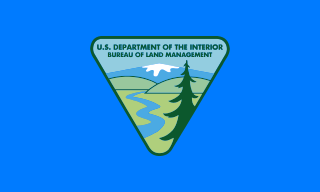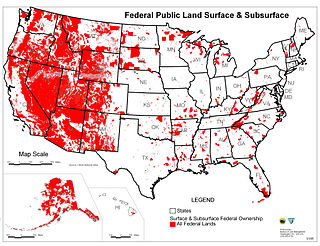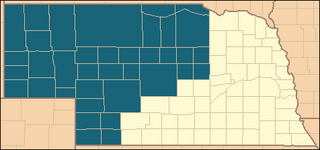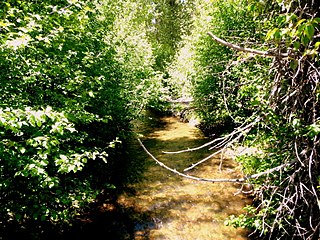Related Research Articles
The Alaska Native Claims Settlement Act (ANCSA) was signed into law by President Richard Nixon on December 18, 1971, constituting at the time the largest land claims settlement in United States history. ANCSA was intended to resolve long-standing issues surrounding aboriginal land claims in Alaska, as well as to stimulate economic development throughout Alaska.

The Bureau of Land Management (BLM) is an agency within the United States Department of the Interior responsible for administering U.S. federal lands. Headquartered in Washington, D.C., the BLM oversees more than 247.3 million acres (1,001,000 km2) of land, or one-eighth of the United States's total landmass.

National Wildlife RefugeSystem (NWRS) is a system of protected areas of the United States managed by the United States Fish and Wildlife Service (FWS), an agency within the Department of the Interior. The National Wildlife Refuge System is the system of public lands and waters set aside to conserve America's fish, wildlife, and plants. Since President Theodore Roosevelt designated Florida's Pelican Island National Wildlife Refuge as the first wildlife refuge in 1903, the system has grown to over 568 national wildlife refuges and 38 wetland management districts encompassing about 856,000,000 acres (3,464,109 km2).
In all modern states, a portion of land is held by central or local governments. This is called public land, state land, or Crown land. The system of tenure of public land, and the terminology used, varies between countries. The following examples illustrate some of the range.
A land grant is a gift of real estate—land or its use privileges—made by a government or other authority as an incentive, means of enabling works, or as a reward for services to an individual, especially in return for military service. Grants of land are also awarded to individuals and companies as incentives to develop unused land in relatively unpopulated countries; the process of awarding land grants are not limited to the countries named below. The United States historically gave out numerous land grants as Homesteads to individuals desiring to prove a farm. The American Industrial Revolution was guided by many supportive acts of legislatures promoting commerce or transportation infrastructure development by private companies, such as the Cumberland Road turnpike, the Lehigh Canal, the Schuylkill Canal and the many railroads that tied the young United States together.

Buckeye is a farming and ranching unincorporated community in north central Larimer County, Colorado, United States. Bounded on the west by the 16,500-acre (67 km2) Roberts Ranch, the area includes Red Mountain Open Space to the north, Rawhide flats to the east, and extends south to Owl Canyon.

Federal lands are publicly owned lands in the United States managed by the federal government. Pursuant to the Property Clause of the United States Constitution, Congress has the power to retain, buy, sell, and regulate federal lands, such as by limiting cattle grazing on them. These powers have been recognized in a long series of United States Supreme Court decisions.
A Hawaiian home land is an area held in trust for Native Hawaiians by the state of Hawaii under the Hawaiian Homes Commission Act of 1920.

The National Wilderness Preservation System (NWPS) of the United States protects federally managed wilderness areas designated for preservation in their natural condition. Activity on formally designated wilderness areas is coordinated by the National Wilderness Preservation System. Wilderness areas are managed by four federal land management agencies: the National Park Service, the U.S. Forest Service, the U.S. Fish and Wildlife Service, and the Bureau of Land Management.

The Kinkaid Act of 1904 is a U.S. statute that amended the 1862 Homestead Act so that one section of public domain land could be acquired free of charge, apart from a modest filing fee. It applied specifically to 37 counties in northwest Nebraska, in the general area of the Nebraska Sandhills. The act was introduced by Moses Kinkaid, Nebraska's 6th congressional district representative, was signed into law by President Theodore Roosevelt on April 28, 1904 and went into effect on June 28 of that year.

The Pascua Yaqui Tribe of Arizona is a federally recognized tribe of Yaqui Native Americans in the state of Arizona.
In 1898, the United States Congress annexed Hawaiʻi based on a Joint Resolution of Annexation. Questions about the legitimacy of the U.S. acquiring Hawaii through a joint resolution, rather than a treaty, were actively debated in Congress in 1898, and is the subject of ongoing debate. Upon annexation, the Republic of Hawai‘i transferred approximately 1.8 million acres of Hawaiian Government and Crown Lands to the United States (U.S.), which are today held by the State of Hawaiʻi. In the 1993 Apology Resolution, the U.S. government officially apologized to the Native Hawaiian people, acknowledging that the Republic of Hawaiʻi transferred these lands "without the consent of or any compensation to the Native Hawaiian people of Hawaiʻi or their sovereign government" and that "the indigenous Hawaiian people never directly relinquished their claims. .. over their national lands to the United States." Although the lands are commonly referred to as "ceded lands" or "public lands," some refer to them as "seized lands" or "Hawaiian national lands" or "crown lands" to highlight the illegal nature of the land transfer, acknowledge different interpretations of the legal effect of the Joint Resolution, and to recognize that Native Hawaiians maintain claims to these lands. Many Native Hawaiian individuals and organizations insist on the return of title, which would be consistent with international law and recognition of the rights of Indigenous peoples, whereas others seek back rent for the use of the land.

The Spanish and Mexican governments made many concessions and land grants in Alta California and Baja California from 1775 to 1846. The Spanish Concessions of land were made to retired soldiers as an inducement for them to settle in the frontier. These Concessions reverted to the Spanish crown upon the death of the recipient.

Sun Pass State Forest is one of six state forests managed by the Oregon Department of Forestry. The forest is located 40 miles (64 km) north of Klamath Falls, Oregon near the southeastern corner of Crater Lake National Park. It is the largest single block of Oregon state forestry land east of the Cascade Mountains. The forest is managed as part of the Klamath-Lake District, comprising 21,317 acres (8,627 ha) of the 33,739 state-owned acres within the district.
The Board of Commissioners of Public Lands, otherwise known as BCPL, is a state agency responsible for investing Wisconsin's school trust funds in support of public education, for managing the state's remaining school trust lands, and for maintaining an extensive archive of land records. The board was established by Article X, Sections 7 and 8 of the Wisconsin Constitution, ratified in 1848, making it Wisconsin's oldest extant state agency.
State trust lands were granted by the United States Congress to states upon entering the Union. These lands were designated to support essential public institutions which are primarily public schools. State trust land managers lease and sell these lands to generate revenue for current and future designated beneficiaries. Predominantly found in the western United States, 46 million acres of land are currently designated as trust lands and the proceeds from the lease and sale of these lands are distributed into a state's permanent fund and used for many purposes.

The State of Utah passed legislation in 2012—the Utah Transfer of Public Lands Act—to require the Federal government to grant the majority of federal land in the state to the state of Utah after 2014. According to Donald J. Kochan, the federal government promised to transfer these lands to the State in the Utah Enabling Act of 1894.

The Sabinoso Wilderness is a 29,855 acres (120.82 km2) area in San Miguel County, New Mexico. The US Bureau of Land Management owns and administers the wilderness area. The semi-arid wilderness includes few natural resources but has a diverse geology, as well as a range of plant and animal species.

The 4,500 acres (1,800 ha) Palo Corona Ranch, also known as Fish Ranch, was once a private ranch located on the northern end of Big Sur, California, between Garrapata State Park to the west, Carmel Valley on the north, and Santa Lucia Preserve to the east. The ranch is now owned by Monterey Peninsula Regional Park District (MPRPD) In 2002, the Big Sur Land Trust and The Nature Conservancy acquired the land and transferred ownership to MPRPD in 2004, which created the Palo Corona Regional Park. Key habitat and resources include coastal grasslands and woodland, ponds, and perennial creeks.

In the United States, governmental entities at all levels- including townships, cities, counties, states, and the federal government- all manage land which are referred to as either public lands or the public domain.
References
- ↑ "Archived copy" (PDF). Archived from the original (PDF) on 2007-04-18. Retrieved 2007-01-09.
{{cite web}}: CS1 maint: archived copy as title (link) - ↑ "ASLD History". Archived from the original on 2013-03-21. Retrieved 2013-02-27.
- ↑ Sonoran Institute, Dan Hunting (2011). "The Quarrel between Past and Present: The Economics of Reforming Arizona's Century Old State Trust Land Rules" (PDF). Retrieved 4 August 2023.
- ↑ Susan Culp, Dan Hunting (May 2012). "Experimenting with Land Value Capture on Western Public Land". Lincoln Institute of Land Policy. Retrieved 4 August 2023.
- ↑ The Trust for Public Land (2017). "Arizona Conservation Programs" . Retrieved 4 August 2023.
- ↑ Coalition for Sonoran Desert Protection (2011). "Arizona State Trust Reform" . Retrieved 4 August 2023.
- ↑ Lane, Bruce Babbitt and Robert. "Saudi firm has pumped Arizona groundwater for years without paying. Time to pony up". The Arizona Republic. Retrieved 2022-11-03.
- ↑ Phillips, Nick (26 April 2023). "Fondomonte well rejection will have little impact". Arizona Capitol Times. Retrieved 4 August 2023.
- ↑ "Why Vanessa Hickman resigned as state land director - Phoenix Business Journal". Archived from the original on 2015-01-20.
- ↑ "Governor Doug Ducey Appoints State Land Commissioner". 22 April 2015.
- ↑ KTAR.COM (2023-01-25). "Arizona Gov. Hobbs names directors of regulation, gaming and state land". KTAR.com. Retrieved 2023-04-19.